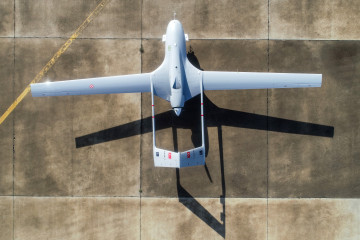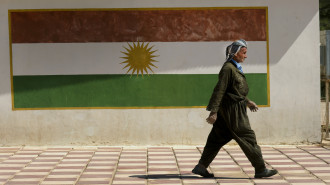

After repeated denials by the Kremlin that it planned to attack its neighbour, the military invasion of Ukraine on 24 February shocked the world.
With Ukrainians showing resolve and resistance against Russian military might, different European nations have announced the transfer of military aid to Ukraine, including anti-tank systems, anti-aircraft weapons, and other firearms and ammunition.
Among the different arms systems used by the Ukrainian army, it is the Turkish-made Bayraktar TB2 unmanned aerial vehicle (UAV) that has received the most attention.
The Ukrainian military claims it has successfully used the drone against the Russian military, with videos posted online purporting to show destroyed Russian vehicles and equipment.
"In recent years, Turkish-made drones have been critical in several conflict arenas around the world, including battlefields in Syria, Libya, and Nagorno-Karabakh, changing the way modern wars are fought"
The drone has even inspired a song, shared online by Ukraine’s armed forces, hailing its success.
But how much difference could the Bayraktar TB2 drone make in the Ukraine war?
In recent years, Turkish-made drones have been critical in several conflict arenas around the world, including battlefields in Syria, Libya, and Nagorno-Karabakh, changing the way modern wars are fought.
The immense list of visually confirmed military losses caused by the Bayraktar drone in these conflicts, composed by the Oryx blog, includes 120 tanks, 47 armoured fighting vehicles, 147 towed artillery, 43 self-propelled artillery, 78 multiple rocket launchers, two ballistic missiles, seven self-propelled anti-aircraft guns, 42 surface-to-air missile systems, seven radar systems, one jammer system, seven aircraft, and 291 vehicles.
While Turkish drones were used with devastating effect against the forces of Bashar al-Assad in Syria and Libyan National Army (LNA) leader Khalifa Haftar in Libya, some analysts argued that the TB2 would only be effective against militias rather than in conventional warfare.
But after their successful use during the Nagorno-Karabakh conflict between Azerbaijan and Armenia, the Bayraktar TB2 drone hit the headlines. During this period, and after seeing their battle prowess, Ukraine invested heavily in Turkish drones, becoming one of the most important customers of Turkey’s military technology.
Despite doubts over the effectiveness of Turkish drones against a serious military power, and claims that Russia had already studied the Bayraktar and concluded it was not a threat due to electronic jamming, Ukraine’s claimed success in its use of drone warfare against Russian forces has shocked many.
Russian news outlets have claimed that the country’s air defence systems have been upgraded to down Turkish drones, with Moscow’s fixation on the weapon extending to claims that it had destroyed most of Ukraine’s TB2s.
However, the Ukrainian army has published several videos of drone strikes against valuable Russian military targets, including air defence systems. This evidence suggests that Russia has not only failed to destroy Ukraine’s drone fleet in the initial invasion, but may also not be capable of downing them.
So far, only one Bayraktar TB2 drone is visually confirmed to have been downed. Last Wednesday, Ukraine’s defence minister said his forces had received new Bayraktar TB2 drones that were “ready for combat”, without further elaborating.
|
|
But while Ukraine’s military can apparently claim some initial successes, it remains to be seen what impact they will have on Russia’s air dominance during the course of the war.
The Bayraktar TB2 is a medium altitude and long-range UAV system manufactured by Baykar Makina in Turkey. The Bayraktar series production began in 2007 and the first flight was made in June 2009.
Bayraktar TB2 UAV can carry a payload of 150kg and operate day and night. The Bayraktar TB2 drone broke its endurance record by flying non-stop for 27 hours and 3 minutes in 2019 in Kuwait.
Moreover, the MAM-L lightweight Smart Micro Munition used by the Bayraktar TB2 drone has been developed for UAVs, light attack aircraft, and air-to-ground missions. MAM-L offers high strike precision and efficiency with alternative warheads against fixed and mobile targets. The Bayraktar TB2 can carry four MAM-L missiles.
These technical advantages of the Bayraktar TB2 give Ukraine the ability to strike Russian targets and disrupt Russian logistic lines. As the Bayraktar TB2 has a long flight time, it is not only used to target Russian forces, but also for surveillance and to guide artillery fire.
"The effect of the Bayraktar TB2 on the battlefield is not limited to its striking capability and surveillance; it is also psychological"
As Ukraine’s military has a disadvantage in air superiority against Russia, the Bayraktar TB2 is essential in enabling air surveillance. Moreover, the TB2 allows Ukraine to monitor and coordinate defence and counter-offensive actions.
The Bayraktar TB2 can monitor Russian forces for around 24 hours and can be redeployed immediately after fuelling and loading munitions. As long as no technical problems occur, the Bayraktar TB2 can remain almost non-stop in the skies.
The effect of the Bayraktar TB2 on the battlefield, however, is not limited to its striking capability and surveillance; it is also psychological. The emotional effect of the drone footage, for example, is immense, with images and videos of successful drone strikes providing much morale for the Ukrainian people and army.
Furthermore, Russian forces have to consider that somewhere above them a Bayraktar TB2 could be watching, ready to strike.
But while the impact of the Bayraktar TB2 drones as force multipliers is immense, their ability to determine the fate of the war will be limited.
While the visually confirmed destruction of 89 tanks and 24 air-defence systems in the Nagorno-Karabakh conflict, or the destruction of 11 air-defence systems in Libya, may have determined the fate of these wars, the Russian military is a giant with a relatively high tolerance capacity.
To date, the visually confirmed Russian losses in the first 11 days of the war exceed 848 different weapon systems. But even if all the estimated 20 Ukrainian Bayraktar drones are functioning, and despite being a nightmare for Russia, they will likely prove no match against Moscow’s military numbers.
"While the impact of the Bayraktar TB2 drones as force multipliers is immense, their ability to determine the fate of the war will be limited"
If attacks cannot be supplemented with the necessary military capability to exploit the momentum provided by the TB2’s strikes, drones alone will not be enough.
While the Bayraktar TB2 will contribute more than its fair share to the war of attrition in Ukraine, the fate of the war will be decided by a complex set of considerations.
Western arms support to Ukraine, economic sanctions against Russia, Moscow’s military and political strategy, the defence capabilities of the Ukrainian army, and the resolve of the Ukrainian people, will be the key determining factors in the outcome of the war.
Ömer Özkizilcik is a foreign policy and security analyst based in Ankara.
Follow him on Twitter: @OmerOzkizilcik




 Follow the Middle East's top stories in English at The New Arab on Google News
Follow the Middle East's top stories in English at The New Arab on Google News


